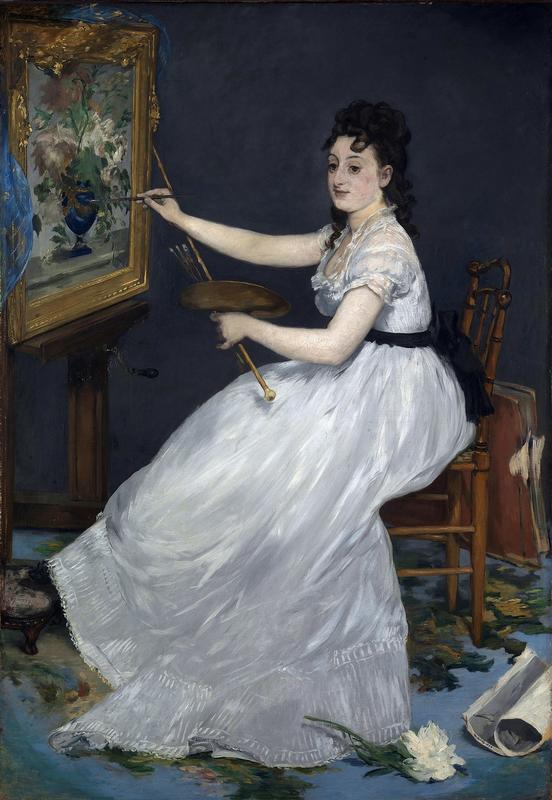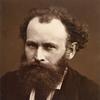More about Eva Gonzalès

Contributor
Edouard Manet’s single most promising and studious pupil, Eva Gonzales, poses for Eva Gonzales.
Gonzales was also the only artist he ever took under his wing. Besides Eva Gonzales, Manet captures his ambitious student painting in his studio the same year in Eva Gonzales Painting in Manet’s Studio. Berthe Morisot, who had grown close to Manet and ended up crushing hard on him, most definitely didn’t like that. Morisot didn’t like that Manet had become so attentive to Gonzales while at the same time pitting the pair against one another, and in a letter written on August 13, 1829, Morisot seems to have felt that Manet thought she was “not capable of anything.”
Eva Gonzales came from an artistic family. Her mother was a musician with her own salon, and her father was Spanish writer, Emmanuel Gonzales. Her painting career began at sixteen when Charles Chaplin (not to be confused with the lovable Charlie) trained her to create society portraits. She remained a pupil of Chaplin until at age 21 she made the acquaintance of Alfred-Emile Stevens, who then introduced her to Manet.
Eva Gonzales came about slowly, as Gonzales had to sit about forty times before Manet completed the painting. In the painting, she wears a snow-white gown, though it's hard to believe a painter would dress in all white and manage not to splash a touch of paint on them. Manet depicted her as an upper-class woman, not as a bohemian artist. While Gonzales paints a still life of peonies in Eva Gonzales, this is not a complete reflection of her body of work, which is also filled with subjects of modern life. However, one of the lessons Manet passed on to her in the 1860s was painting flowers.
The year Eva Gonzales debuted at the Salon was the same year Gonzales exhibited one of her paintings, The Little Soldier. Manet’s influence on Gonzales was noted as early as her Salon debut where, though she described herself as a pupil of Chaplin, others saw right through her and noted that Gonzales, like Manet, omitted half-tones and favored black. Manet’s influence also extended to Gonzales’s use of loose, sensuous brushstrokes and striking light and shade contrasts.
Gonzales went on to marry Henri Guerard, an engraver. From 1870, her career as a painter was humble but respected, and her clientele remained small. If the story of Edouard Manet’s and Eva Gonzales’s relationship was ever turned into a book, it would have made a great one, and then an even better Hollywood film, because six days after Manet died, Gonzales succumbed too, dying from complication in childbirth.
Eva Gonzales is one of a handful of paintings shared between London and Dublin every six years. This is thanks to the paintings’ owner, Sir Hugh Lane, who boarded the ill-fated Lusitania and drowned, leaving a new will behind. Before his death, Lane apparently wrote in his will that this collection should be given to Dublin, once they built a gallery that could properly house the paintings. The twist in the story is this: nobody witnessed this will. Meanwhile, his officiated will says he left the paintings to the National Gallery in London, making them the legal owner. A compromise saw the best of these paintings (including a Renoir and Pissarro as well) traveling back and forth, while thirty-one remain on long-term loan at the Hugh Lane gallery. In 1904, Lane was introduced to the works of the Impressionists and shortly after bought Eva Gonzales, along with Manet’s Music in the Tuileries Gardens from French art dealer Paul-Durand-Ruel.
Sources
- Fahy, Everett. The Wrightsman Pictures. New York: The Metropolitan Museum of Art, 2005.
- Foster, Roy, “How Ireland was robbed of Hugh Lane’s great art collection,” The Guardian, May 30, 2015. Accessed October 4, 2021. https://www.theguardian.com/artanddesign/2015/may/30/how-ireland-was-ro…
- Marlow, Lara, “Berthe Morisot: ‘I have sinned, I have suffered, I have atoned’,” The Irish Times, January 12, 2019. Accessed October 1, 2021. https://www.irishtimes.com/culture/art-and-design/visual-art/berthe-mor…
- Pes, Javier, “The National gallery in London and the Hugh Lane Gallery in Dublin are hatching a secretive agreement ahead of Brexit to share paintings,” Artnet News, September 20, 2019. Accessed October 4, 2021. https://news.artnet.com/art-world/impressionist-dublin-national-gallery…
- Press Association, “Dublin pressures London to return priceless impressionist paintings,” The Guardian, January 9, 2016. Accessed October 4, 2021. https://www.theguardian.com/world/2016/jan/08/dublin-ireland-pressures-…
- Sack, Emily, “Manet portraits: the blurred boundaries between portrait and genre painting – review,” Artlyst, January 25, 2013. Accessed October 1, 2021. https://www.artlyst.com/reviews/manet-portraits-the-blurred-boundaries-…
- Smee, Sebastian, “Eva Gonzales was Edouard Manet’s student. This was her masterpiece.,” The Washington Post, September 29, 2021. Accessed October 1, 2021. https://www.washingtonpost.com/arts-entertainment/interactive/2021/eva-…
- Strieter, Terry W. Nineteenth-Century European Art: A Tropical Dictionary. Westport, CT: Greenwood Press, 1999.
- Thomas, Abreeza, “Painting of the week: Edouard Manet’s Portrait of Eva Gonzales,” Daily Art Magazine, July 25, 2021. Accessed October 1, 2021. https://www.dailyartmagazine.com/edouard-manets-portrait-of-eva-gonzale…
- Tinterow, Gary, Loyrette, Henri. The Origins of Impressionism. New York, NY: The Metropolitan Museum of Art, 1994.











